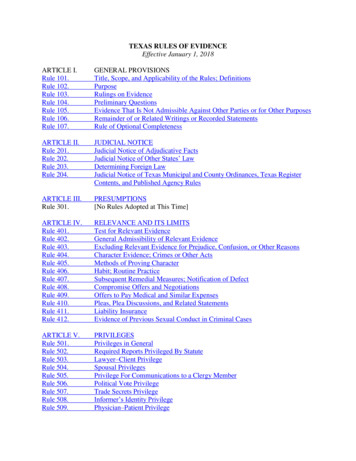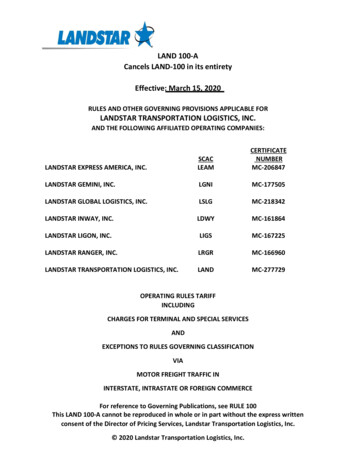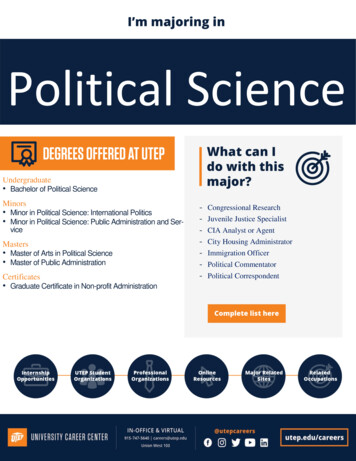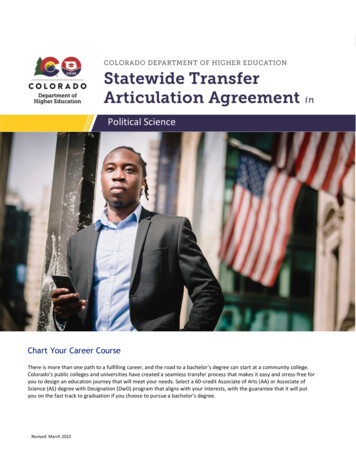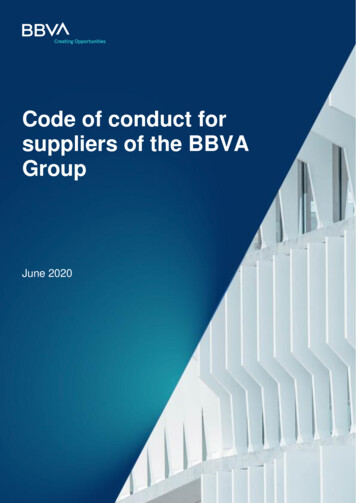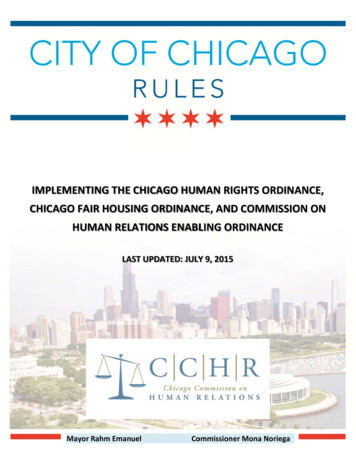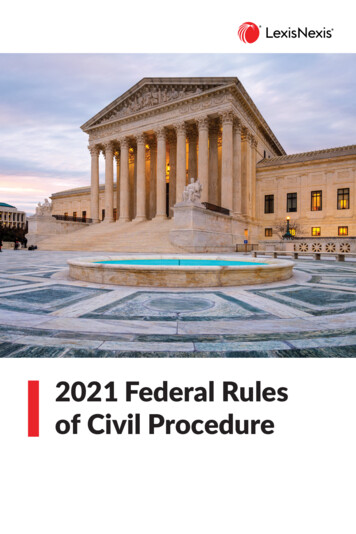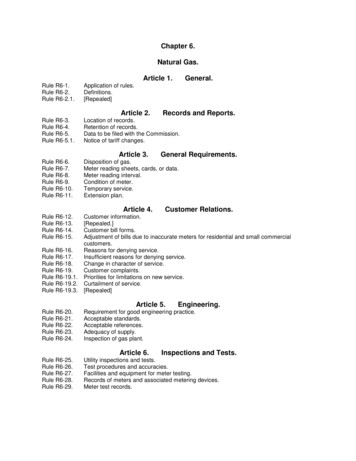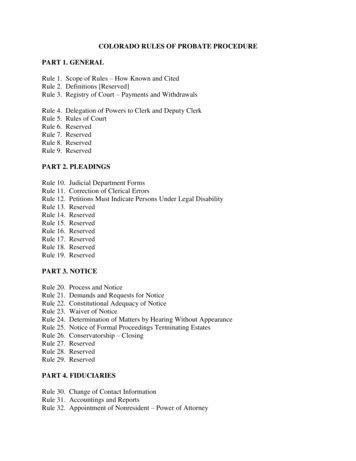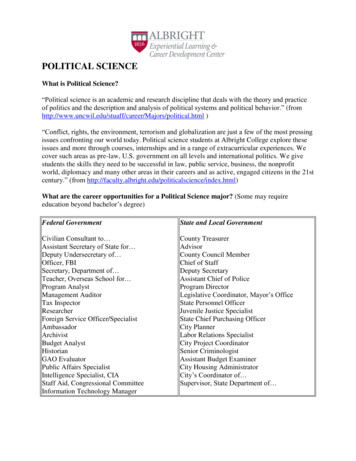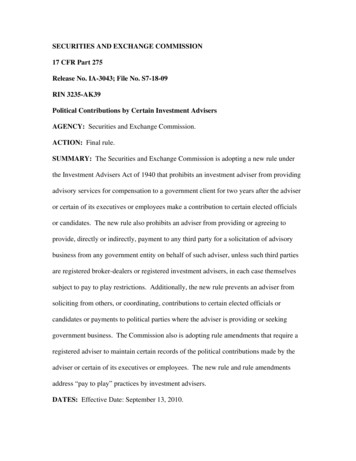
Transcription
SECURITIES AND EXCHANGE COMMISSION17 CFR Part 275Release No. IA-3043; File No. S7-18-09RIN 3235-AK39Political Contributions by Certain Investment AdvisersAGENCY: Securities and Exchange Commission.ACTION: Final rule.SUMMARY: The Securities and Exchange Commission is adopting a new rule underthe Investment Advisers Act of 1940 that prohibits an investment adviser from providingadvisory services for compensation to a government client for two years after the adviseror certain of its executives or employees make a contribution to certain elected officialsor candidates. The new rule also prohibits an adviser from providing or agreeing toprovide, directly or indirectly, payment to any third party for a solicitation of advisorybusiness from any government entity on behalf of such adviser, unless such third partiesare registered broker-dealers or registered investment advisers, in each case themselvessubject to pay to play restrictions. Additionally, the new rule prevents an adviser fromsoliciting from others, or coordinating, contributions to certain elected officials orcandidates or payments to political parties where the adviser is providing or seekinggovernment business. The Commission also is adopting rule amendments that require aregistered adviser to maintain certain records of the political contributions made by theadviser or certain of its executives or employees. The new rule and rule amendmentsaddress “pay to play” practices by investment advisers.DATES: Effective Date: September 13, 2010.
--2-Compliance Dates: Investment advisers subject to rule 206(4)-5 must be in compliancewith the rule on March 14, 2011. Investment advisers may no longer use third parties tosolicit government business except in compliance with the rule on September 13, 2011.Advisers to registered investment companies that are covered investment pools mustcomply with the rule by September 13, 2011. Advisers subject to rule 204-2 mustcomply with amended rule 204-2 on March 14, 2011. However, if they advise registeredinvestment companies that are covered investment pools, they have until September 13,2011 to comply with the amended recordkeeping rule with respect to those registeredinvestment companies. See section III of this Release for further discussion ofcompliance dates.FOR FURTHER INFORMATION CONTACT: Melissa A. Roverts, Senior Counsel,Matthew N. Goldin, Branch Chief, Daniel S. Kahl, Branch Chief, or Sarah A. Bessin,Assistant Director, at (202) 551-6787 or IArules@sec.gov, Office of Investment AdviserRegulation, Division of Investment Management, U.S. Securities and ExchangeCommission, 100 F Street, NE, Washington, DC 20549-8549.SUPPLEMENTARY INFORMATION: The Commission is adopting rule 206(4)-5[17 CFR 275.206(4)-5] and amendments to rules 204-2 [17 CFR 275.204-2] and 206(4)-3[17 CFR 275.206(4)-3] under the Investment Advisers Act of 1940 [15 U.S.C. 80b](“Advisers Act” or “Act”).1115 U.S.C. 80b. Unless otherwise noted, when we refer to the Advisers Act, or anyparagraph of the Advisers Act, we are referring to 15 U.S.C. 80b of the United StatesCode, at which the Advisers Act is codified, and when we refer to rule 206(4)-5, rule204-2, rule 204A-1, rule 206(4)-3, or any paragraph of these rules, we are referring to 17CFR 275.206(4)-5, 17 CFR 275.204-2, 17 CFR 275.204A-1 and 17 CFR 275.206(4)-3,respectively, of the Code of Federal Regulations, in which these rules are published.
--3-TABLE OF CONTENTSI.BACKGROUND . 5II.DISCUSSION . 15A. First Amendment Considerations . 19B. Rule 206(4)-5 . 251. Advisers Subject to the Rule. 292. Pay to Play Restrictions . 31(a) Two-Year “Time Out” for Contributions . 31(1) Prohibition on Compensation. 38(2) Officials of a Government Entity . 43(3) Contributions. 46(4) Covered Associates . 49(5) “Look Back”. 58(6) Exceptions for De Minimis Contributions . 62(7) Exception for Certain Returned Contributions. 65(b) Ban on Using Third Parties to Solicit Government Business . 70(1) Registered Broker-Dealers . 87(2) Registered Investment Advisers. 90(c) Restrictions on Soliciting and Coordinating Contributions and Payments. 93(d) Direct and Indirect Contributions or Solicitations . 96(e) Covered Investment Pools . 97(1) Definition of “Covered Investment Pool”. 102(2) Application of the Rule . 109(3) Subadvisory Arrangements . 111(f)Exemptions . 114D. Recordkeeping . 116E. Amendment to Cash Solicitation Rule. 121III.A.B.C.D.IV.EFFECTIVE AND COMPLIANCE DATES. 122Two-Year Time Out and Prohibition on Soliciting orCoordinating Contributions . 122Prohibition on Using Third Parties to Solicit Government Business and CashSolicitation Rule Amendment. 123Recordkeeping . 125Registered Investment Companies. 125COST-BENEFIT ANALYSIS. 127A. Benefits . 130B. Costs. 1361. Compliance Costs Related to Rule 206(4)-5 . 1362. Other Costs Related to Rule 206(4)-5. 148(a) Two-Year Time Out. 148(b) Third-Party Solicitor Ban. 1543. Costs Related to the Amendments to Rule 204-2 . 159
--4-V.PAPERWORK REDUCTION ACT . 162A.B.C.D.VI.Rule 204-2. 162Rule 206(4)-3 . 171Rule 206(4)-7 . 174Rule 0-4. 176FINAL REGULATORY FLEXIBILITY ANALYSIS . 176A.B.C.D.E.Need for the Rule . 179Significant Issues Raised by Public Comment . 180Small Entities Subject to Rule . 181Projected Reporting, Recordkeeping, and Other Compliance Requirements. 183Agency Action to Minimize Effect on Small Entities . 184VII.EFFECTS ON COMPETITION, EFFICIENCY AND CAPITALFORMATION . 188VIII. STATUTORY AUTHORITY . 191
--5--I.BACKGROUNDInvestment advisers provide a wide variety of advisory services to state and localgovernments,2 including managing their public pension plans.3 These pension planshave over 2.6 trillion of assets and represent one-third of all U.S. pension assets.4 Theyare among the largest and most active institutional investors in the United States;5 themanagement of these funds affects publicly held companies6 and the securities markets.7But most significantly, their management affects taxpayers and the beneficiaries of these2See SOFIA ANASTOPOULOS, AN INTRODUCTION TO INVESTMENT ADVISERS FOR STATEAND LOCAL GOVERNMENTS (2d ed. 2007); Werner Paul Zorn, Public EmployeeRetirement Systems and Benefits, LOCAL GOVERNMENT FINANCE, CONCEPTS ANDPRACTICES 376 (John E. Peterson & Dennis R. Strachota eds., 1st ed. 1991) (discussingthe services investment advisers provide for public funds).3To simplify the discussion, we use the term “public pension plan” interchangeably with“government client” and “government entity” in this Release. However, our rule appliesbroadly to investment advisory activities for government clients, such as those mentionedhere in this Section of the Release, regardless of whether they are retirement funds. For adiscussion of how the proposed rule would apply with respect to investment programs orplans sponsored or established by government entities, such as “qualified tuition plans”authorized by section 529 of the Internal Revenue Code [26 U.S.C. 529] and retirementplans authorized by section 403(b) or 457 of the Internal Revenue Code [26 U.S.C.403(b) or 457], see section II.B.2(e) of this Release.4BOARD OF GOVERNORS OF THE FEDERAL RESERVE SYSTEM, FLOW OF FUNDS ACCOUNTSOF THE UNITED STATES, FLOWS AND OUTSTANDINGS, FOURTH QUARTER 2009 78tbl.L.119 (Mar. 11, 2010). Since 2002, total financial assets of public pension fundshave grown by 28%. Id.5According to a recent survey, seven of the ten largest pension funds were sponsored bystate and municipal governments. The Top 200 Pension Funds/Sponsors, PENS. & INV.(Sept. 30, 2008), available 01209995.6See Stephen J. Choi & Jill E. Fisch, On Beyond CalPERS: Survey Evidence on theDeveloping Role of Public Pension Funds in Corporate Governance, 61 VAND. L.REV. 315 (2008) (“Collectively, public pension funds have the potential to be a powerfulshareholder force, and the example of CalPERS and its activities have spurred many toadvocate greater institutional activism.”).7Federal Reserve reports indicate that, of the 2.6 trillion in non-federal government plans, 1.5 trillion is invested in corporate equities. BOARD OF GOVERNORS OF THE FEDERALRESERVE SYSTEM, supra note 4, at 78 tbl.L.119.
--6-funds, including the millions of present and future state and municipal retirees8 who relyon the funds for their pensions and other benefits.9 Public pension plan assets are held,administered and managed by government officials who often are responsible forselecting investment advisers to manage the funds they oversee.Elected officials who allow political contributions to play a role in themanagement of these assets and who use these assets to reward contributors violate thepublic trust. Moreover, they undermine the fairness of the process by which publiccontracts are awarded. Similarly, investment advisers that seek to influence governmentofficials’ awards of advisory contracts by making or soliciting political contributions tothose officials compromise their fiduciary duties to the pension plans they advise anddefraud prospective clients. These practices, known as “pay to play,” distort the processby which advisers are selected.10 They can harm pension plans that may subsequentlyreceive inferior advisory services and pay higher fees. Ultimately, these violations oftrust can harm the millions of retirees that rely on the plan or the taxpayers of the stateand municipal governments that must honor those obligations.118See PAUL ZORN, 1997 SURVEY OF STATE AND LOCAL GOVERNMENT EMPLOYEERETIREMENT SYSTEMS 61 (1997) (hereinafter “1997 SURVEY”) (“[t]he investment ofplan assets is an issue of immense consequence to plan participants, taxpayers, and to theeconomy as a whole” as a low rate of return will require additional funding from thesponsoring government, which “can place an additional strain on the sponsoringgovernment and may require tax increases”).9The most current census data reports that public pension funds have 18.6 millionbeneficiaries. 2007 Census of Governments, U.S. Bureau of Census, Number andMembership of State and Local Government Employee-Retirement Systems by State:2006-2007 (2007) (at Table 5), available .10Among other things, pay to play practices may manipulate the market for advisoryservices by creating an uneven playing field among investment advisers. These practicesalso may hurt smaller advisers that cannot afford the required contributions.11See1997 SURVEY, supra note 8.
--7-Pay to play practices are rarely explicit: participants do not typically let it bepublicly known that contributions or payments are made or accepted for the purpose ofinfluencing the selection of an adviser. As one court noted, “[w]hile the risk ofcorruption is obvious and substantial, actors in this field are presumably shrewd enoughto structure their relations rather indirectly.”12 Pay to play practices may take a variety offorms, including an adviser’s direct contributions to government officials, an adviser’ssolicitation of third parties to make contributions or payments to government officials orpolitical parties in the state or locality where the adviser seeks to provide services, or anadviser’s payments to third parties to solicit (or as a condition of obtaining) governmentbusiness. As a result, the full extent of pay to play practice remains hidden and is oftenhard to prove.Public pension plans are particularly vulnerable to pay to play practices.Management decisions over these investment pools, some of which are quite large, aretypically made by one or more trustees who are (or are appointed by) elected officials.And the elected officials or appointed trustees that govern the funds are also ofteninvolved, directly or indirectly, in selecting advisers to manage the public pension funds’assets. These officials may have the sole authority to select advisers,13 may be membersof a governing board that selects advisers,14 or may appoint some or all of the boardmembers who make the selection.1512Blount v. SEC, 61 F.3d 938, 945 (D.C. Cir. 1995), cert. denied, 517 U.S. 1119 (1996).13See, e.g., 2 N.Y. COMP. CODES R. & REGS. TIT. 2 § 320.2 (2009) (placement of state andlocal government retirement systems assets (valued at 109 billion as of March 2009) isunder the sole custodianship of the New York State Comptroller).14See, e.g., S.C. CODE ANN. §§ 9-1-20, 1-11-10 (2008) (board consists of all electedofficials); CAL. GOV’T CODE § 20090 (Deering 2008) (board consists of some electedofficials, some appointed members, and some representatives of interest groups chosen
--8-Numerous developments in recent years have led us to conclude that the selectionof advisers, whom we regulate under the Investment Advisers Act, has been influencedby political contributions and that, as a result, the quality of management serviceprovided to public funds may be negatively affected. We have been particularlyconcerned that these contributions have been funneled through “solicitors” and“placement agents” that advisers engage (or believe they must engage) in order to securea client relationship with a public pension plan or an investment from one.16 As we willdiscuss in more detail below, in such an arrangement the contribution may be made in theform of a substantial fee for what may constitute no more than an introduction service bya “well connected” individual who may use the proceeds of the fee to make (or reimbursehimself for having made) political contributions or provide some form of a “kickback” toan official or his or her family or friends.17by the members of those groups); MD. CODE ANN., STATE PERS. & PENS. § 21-104(2008) (pension board consists of some elected officials, some appointed members, andsome representatives of interest groups chosen by the members of those groups).15See, e.g., ARIZ. REV. STAT. ANN. § 38-713 (2008) (governor appoints all nine members);HAWAII REV. STAT. § 88-24 (2008) (governor appoints three of eight members); IDAHOCODE ANN. § 59-1304 (2008) (governor appoints all five members).16For example, in one recent action we alleged that, in connection with a pay to playscheme in New York State, investment advisers paid sham “placement agent” fees,portions of which were funneled to public officials, as a means of obtaining publicpension fund investments in the funds those advisers managed and that participants, insome instances, concealed the third-party solicitor’s role in transactions from theinvestment management firms that paid fees to the solicitor by making misrepresentationsabout the solicitor’s involvement and covertly using one of the solicitor’s legal entities asan intermediary to funnel payments to the solicitor. SEC v. Henry Morris, et al.,Litigation Release No. 20963 (Mar. 19, 2009).17See id. (along with the Commission’s complaint in the action, available by way of ahyperlink from the litigation release). See also, e.g., In the Matter of Quadrangle GroupLLC, AGNY Investigation No. 2010-044 (Apr. 15, 2010) (finding that “private equityfirms and hedge funds frequently use placement agents, finders, lobbyists, and otherintermediaries . . . to obtain investments from public pension funds . . . , that theseplacement agents are frequently politically connected individuals selling access to publicmoney. . .”); Complaint, Cal. v. Villalobos, et al., No. SC107850 (Cal. Super. Ct., W.
--9-The details of pay to play arrangements have been widely reported as aconsequence of the growing number of actions that we and state authorities have broughtinvolving investment advisers seeking to manage the considerable assets of the NewYork State Common Retirement Fund.18 In addition, we have brought enforcementactions against the former treasurer of the State of Connecticut and other parties in whichwe alleged that the former treasurer awarded state pension fund investments to privateequity fund managers in exchange for payments, including political contributions,funneled through the former treasurer’s friends and political associates.19 CriminalDist. of L.A. County, May 5, 2010), available athttp://ag.ca.gov/cms attachments/press/pdfs/n1915 filed complaint for civil penalties.pdf (alleging, inter alia, that a top executive and a board member at CalPERS acceptedvarious gifts from a former CalPERS board member, “known among private equity firmsas a person who attempts to exert pressure on CalPERS’ representatives,” who was actingas a placement agent trying to secure investments from the California public pensionfund).18See SEC v. Henry Morris, et al., Litigation Release No. 21036 (May 12, 2009); In theMatter of Quadrangle Group LLC, AGNY Investigation No. 2010-044 (Apr. 15, 2010);In the Matter of GKM Newport Generation Capital Servs., LLC, AGNY InvestigationNo. 2010-017 (Apr. 14, 2010); In the Matter of Kevin McCabe, AGNY Investigation No.2009-152 (Apr. 14, 2010); In the Matter of Darius Anderson Platinum Advisors LLC,AGNY Investigation No. 2009-153 (Apr. 14, 2010); In the Matter of Global StrategyGroup, AGNY Investigation No. 2009-161 (Apr. 14, 2010); In the Matter of FreemanSpogli & Co., AGNY Investigation No. 2009-174 (Feb. 1, 2010); In the Matter ofFalconhead Capital, LLC, AGNY Investigation No. 2009-125 (Sept. 17, 2009); In theMatter of HM Capital Partners I, LP, AGNY Investigation No. 2009-117 (Sept. 17,2009); In the Matter of Ares Management LLC, AGNY Investigation No. 2009-173 (Feb.17, 2010); In the Matter of Levine Leichtman Capital Partners, AGNY Investigation No.2009-124 (Sept. 17, 2009); In the Matter of Access Capital Partners, AGNYInvestigation No. 09-135 (Sept. 17, 2009); In the Matter of The Markstone Group,AGNY Investigation No. 10-012 (Feb. 28, 2010); In the Matter of Wetherly CapitalGroup, LLC and DAV/Wetherly Financial, L.P., AGNY Investigation No. 2009-172(Feb. 8, 2010) (in each case, banning the use of third-party placement agents pursuant toa “Pension Reform Code of Conduct”).19See SEC v. Paul J. Silvester, et al., Litigation Release No. 16759 (Oct. 10, 2000);Litigation Release No. 20027 (Mar. 2, 2007); Litigation Release No. 19583 (Mar. 1,2006); Litigation Release No. 18461 (Nov. 17, 2003); Litigation Release No. 16834(Dec. 19, 2000); SEC v. William A. DiBella et al., Litigation Release No. 20498 (Mar. 14,2008) (2007 U.S. Dist. LEXIS 73850 (D. Conn., May 8, 2007), aff’d 587 F.3d 553 (2ndCir. 2009)). See also U.S. v. Ben F. Andrews, Litigation Release No. 19566 (Feb. 15,
--10-authorities have in recent years brought cases in New York,20 New Mexico,21 Illinois,22Ohio,23 Connecticut,24 and Florida,25 charging defendants with the same or similarconduct.2006); In the Matter of Thayer Capital Partners, TC Equity Partners IV, L.L.C., TCManagement Partners IV, L.L.C., and Frederick V. Malek, Investment Advisers ActRelease No. 2276 (Aug. 12, 2004); In the Matter of Frederick W. McCarthy, InvestmentAdvisers Act Release No. 2218 (Mar. 5, 2004); In the Matter of Lisa A. Thiesfield,Investment Advisers Act Release No. 2186 (Oct. 29, 2003).20See New York v. Henry “Hank” Morris and David Loglisci, Indictment No. 25/2009 (NYMar. 19, 2009) (alleging that the deputy comptroller and a “placement agent” engaged inenterprise corruption and state securities fraud for selling access to management of publicfunds in return for kickbacks and other payments for personal and political gain).21See U.S. v. Montoya, Criminal No. 05-2050 JP (D.N.M. Nov. 8, 2005) (the formertreasurer of New Mexico pleaded guilty); U.S. v. Kent Nelson, Criminal Information No.05-2021 JP, (D.N.M. 2007) (defendant pleaded guilty to one count of mail fraud); U.S. v.Vigil, 523 F. 3d 1258 (10th Cir. 2008) (affirming the conviction for attempted extortionof the former treasurer of New Mexico for requiring that a friend be hired by aninvestment manager at a high salary in return for the former treasurer’s willingness toaccept a proposal from the manager for government business).22See Jeff Coen, et al., State’s Ultimate Insider Indicted, CHI. TRIB., Oct. 31, 2008,available at ni-31 oct31,0,6465036.story (describing the thirteenth indictment in an Illinois pay to playprobe); Ellen Almer, Oct. 27, 2000, available at http://www.chicagobusiness.com/cgi bin/news.pl?id 775 (discussing the guilty plea of Miriam Santos, the former treasurer ofthe City of Chicago, who told representatives of financial services firms seeking citybusiness that they were required to raise specified campaign contributions for her andpersonally make up any shortfall in the amounts they raised). See also SEC v. MiriamSantos, et al., Litigation Release No. 17839 (Nov. 14, 2002); Litigation Release No.19269 (June 14, 2005) (355 F. Supp. 2d 917 (N.D. Ill. 2003)).23See Reginald Fields, Four More Convicted in Pension Case: Ex-Board MembersTook Gifts from Firm, CLEVELAND PLAIN DEALER, Sept. 20, 2006 (addressing pay toplay activities of members of the Ohio Teachers Retirement System).24See U.S. v. Joseph P. Ganim, 2007 U.S. App. LEXIS 29367 (2d Cir. 2007) (affirming thedistrict court’s decision to uphold an indictment of the former mayor of Bridgeport,Connecticut, in connection with his conviction for, among other things, requiringpayment from an investment adviser in return for city business); U.S. v. Triumph CapitalGroup, et al., No. 300CR217 JBA (D. Conn. 2000) (the former treasurer, along withcertain others, pleaded guilty—while others were ultimately convicted). One of thedefendants, who had been convicted at trial, recently won a new trial. U.S. v. TriumphCapital Group, et al., 544 F.3d 149 (2d Cir. 2008).25United States v. Poirier, 321 F.3d 1024 (11th Cir.), cert. denied sub nom. deVegter v.United States, 540 U.S. 874 (2003) (partner at Lazard Freres & Co., a municipal servicesfirm, was convicted for conspiracy and wire fraud for fraudulently paying 40,000
--11-Allegations of pay to play activity involving state and municipal pension plans inother jurisdictions continue to be reported.26 In the course of this rulemaking we receiveda letter from one public official detailing the role of pay to play arrangements in theselection of public pension fund managers and the harms it can inflict on the affectedplans.27 In addition, other public officials wrote to express support for a Commission ruleto prohibit investment advisers from participating in pay to play arrangements.28On August 3, 2009, we proposed a new antifraud rule under the Advisers Actdesigned to prevent investment advisers from obtaining business from governmententities in return for political contributions or fund raising—i.e., from participating in paythrough an intermediary to Fulton County’s independent financial adviser to secure anassurance that Lazard would be selected for the Fulton County underwriting contract).26See, e.g., Aaron Lester, et al., Cahill Taps Firms Tied to State Pension Investor,BOSTON.COM, Mar. 21, 2010 (suggesting that an investment adviser may have bundledout-of-state donations to the Massachusetts State Treasurer’s campaign in return for astate pension fund investment management contract); Kevin McCoy, Do CampaignContributions Help Win Pension Fund Deals, USA TODAY, Aug. 28, 2009; TedSherman, Pay to Play Alive and Well in New Jersey, NJ.COM, Nov. 28, 2009 (notingmore generally that pay to play continues to occur with government contracts of all kindsin New Jersey); Imogen Rose-Smith and Ed Leefeldt, Pension Pay to Play Casts ShadowNationwide, INSTITUTIONAL INVESTOR, Oct. 1, 2009 (suggesting connections between aprivate equity fund principal’s fundraising activities and pension investments in thefund). See also sources cited supra note 17.27Comment Letter of Suzanne R. Weber, Erie County Controller (Oct. 6, 2009) (“WeberLetter”) (“I have seen money managers awarded contracts with our fund which involvedpayments to individuals who served as middlemen, creating needless expense for thefund. These middlemen were political contributors to the campaigns of board memberswho voted to contract for money management services with the companies who paidthem as middlemen.”). See also Comment Letter of David R. Pohndorf (Aug. 4, 2009)(“Pohndorf Letter”) (noting that when the sole trustee of a major pension fund changedseveral years ago, a firm managing some of the fund’s assets “began to receiveinvitations to fundraising events for the new trustee with suggested donation amounts.”).28See, e.g., Comment Letter of New York State Comptroller Thomas P. DiNapoli (Oct. 2,2009) (“DiNapoli Letter”); Comment Letter of New York City Mayor Michael R.Bloomberg (Sept. 9, 2009) (“Bloomberg Letter”). See also Comment Letter of KentuckyRetirement Systems Trustee Chris Tobe (Sept. 18, 2009) (“Tobe Letter”) (suggesting thenegative effects of pay to play activities on the Kentucky Retirement System’sinvestment performance).
--12-to play practices.29 We modeled our proposed rule on those adopted by the MunicipalSecurities Rulemaking Board, or MSRB, which since 1994 has prohibited municipalsecurities dealers from participating in pay to play practices.30 We believe these ruleshave significantly curbed pay to play practices in the municipal securities market.31Along the lines of MSRB rule G-37,32 our proposed rule would have prohibited aninvestment adviser from providing advisory services for compensation to a governmentclient for two years after the adviser or certain of its executives or employees make acontribution to certain elected officials or candidates.33 It also would have prohibited anadviser and certain of its executives and employees from soliciting from others, orcoordinating, contributions to certain elected officials or candidates or payments topolitical parties where the adviser is providing or seeking government business.34 In29Political Contributions by Certain Investment Advisers, Investment Advisers Act ReleaseNo. 2910 (Aug. 3, 2009) [74 FR 39840 (Aug. 7, 2009)] (the “Proposing Release”).30MSRB rule G-37 was approved by the Commission and adopted in 1994. See In theMatter of Self-Regulatory Organizations; Order Approving Proposed Rule Change by theMunicipal Securities Rulemaking Board Relating to Political Contributions andProhibitions on Municipal Securities Business and Notice of Filing and Order Approvingon an Accelerated Basis Amendment No. 1 Relating t
Code, at which the Advisers Act is codified, and when we refer to rule 206(4)-5, rule 204-2, rule 204A-1, rule 206(4)-3, or any paragraph of these rules, we are referring to 17 CFR 275.206(4)-5, 17 CFR 275.204-2, 17 CFR 275.204A-1 and 17 CFR 275.206(4)-3, respectively, of the Code of Federal Regulations, in which these rules are published. 1

